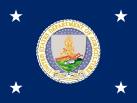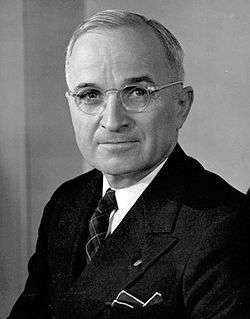Charles F. Brannan
| Charles F. Brannan | |
|---|---|
 | |
| 14th United States Secretary of Agriculture | |
|
In office June 2, 1948 – January 20, 1953 | |
| President | Harry S. Truman |
| Preceded by | Clinton P. Anderson |
| Succeeded by | Ezra Taft Benson |
| Personal details | |
| Born |
Charles Franklin Brannan August 23, 1903 Denver, Colorado, U.S. |
| Died |
July 2, 1992 (aged 88) Denver, Colorado, U.S. |
| Nationality | American |
| Political party | Democratic Party |
| Spouse(s) |
Eda V. Seltzer (1906 - 2006) |
| Alma mater |
Regis University University of Denver Law |
| Religion | Quaker |
Charles Franklin Brannan (August 23, 1903 – July 2, 1992) was the United States Secretary of Agriculture from 1948 to 1953. He was a liberal Democrat best known for proposing the "Brannan Plan", which was rejected by a conservative Congress and never took effect.
Biography
Brannan was born in Denver, Colorado, on August 23, 1903. He came from a Quaker family; his father was an engineer. He received his law degree from the University of Denver law school in 1929. In 1932, Brannan married Eda V. Seltzer. He practiced law in Denver, specializing in agricultural, mining, and irrigation issues. He was an ardent Democrat and supporter of the New Deal.
Government lawyer
He began as a lawyer in the Resettlement Administration, where he relocated destitute tenant farmers hurt by the "dust bowl." In 1937 he became a regional attorney for the Department of Agriculture. In 1941 he moved to the Farm Security Administration, where he arranged loans for water facilities and needy farmers in the Mountain states. In 1944, he became assistant secretary of agriculture under Secretary Clinton Anderson, who put him in charge of long-range planning. When Anderson resigned in 1948, he recommended Brannan as did the president of the liberal Farmers Union.
Secretary of Agriculture, 1948-1953
In 1949, he advocated the Brannan Plan, as part of President Truman's Fair Deal program. Brannan wanted to guarantee farmers income, while letting free market forces determine the prices of commodities. That plan was not enacted by the Republican controlled congress, which was focusing on the Cold War.
Following the election of Dwight D. Eisenhower in 1953, Brannan left the government and became the general counsel for the National Farmers Union, a position in which he served until 1990. Brannan died on July 2, 1992, at age 88, in Denver. Brannan was the last surviving member of the Truman Cabinet.
_Secretary_of_Defense_Louis..._-_NARA_-_200166.jpg)
Further reading
- Christenson, Reo Millard. The Brannan Plan (University of Michigan Press, 1959)
- Dean, Virgil W. "Why Not the Brannan Plan?" Agricultural History (1996) 70#2 pp. 268-282 in JSTOR
- Dean, Virgil W. An opportunity lost: The Truman administration and the farm policy debate (University of Missouri Press, 2006) online
- Dean, Virgil W. "Farm Policy and Truman's 1948 Campaign." Historian (1993) 55#3 pp: 501-516
- Matusow, Allen J. Farm policies and politics in the Truman years (Harvard University Press, 1967).
- Pratt, William C. "The Farmers Union, McCarthyism, and the Demise of the Agrarian Left." Historian (1996) 58#2 pp: 329-342. online
- Schoenebaum, Eleonora W. ed. Political Profiles: The Truman Years (1978) pp 51-53
External links
| Wikimedia Commons has media related to Charles F. Brannan. |
- A film clip "Longines Chronoscope with Charles F. Brannan" is available for free download at the Internet Archive
| Political offices | ||
|---|---|---|
| Preceded by Clinton P. Anderson |
U.S. Secretary of Agriculture Served under: Harry S. Truman 1948–1953 |
Succeeded by Ezra Taft Benson |
| ||||||||
|

